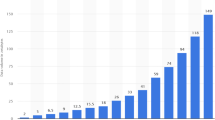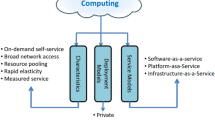Abstract
Cloud computing is an emerging field in computer science. Users are utilizing less of their own existing resources, while increasing usage of cloud resources. There are many advantages of distributed computing over centralized architecture. With increase in number of unused storage and computing resources and advantages of distributed computing resulted in distributed cloud computing. In the distributed cloud environment that we propose, resource providers (RP) compete to provide resources to the users. In the distributed cloud all the cloud computing and storage services are offered by distributed resources. In this architecture resources are used and provided by the users in a peer to peer fashion. We propose using multi-valued distributed hash tables for efficient resource discovery. Leveraging the fact that there are many users providing resources such as CPU and memory, we define these resources under one key to easily locate devices with equivalent resources. We have evaluated the performance of resource discovery mechanisms for the distributed cloud and distributed cloud storage and compared the results with existing DHTs, peer to peer clients such as VUZE [1] and explored the feasibility and efficiency of the proposed schemes in terms of resource/service discovery and allocation. We use a simultaneous Auction mechanism and select a set of winners once we receive all contributions or bids. In a real world scenario, users request resources with multiple capabilities, and in order to find such resources we use a contribution mechanism where service providers will provide a contribution price to users for providing a resource. Users use our proposed auction mechanism to select the resources from the set of resource providers. We show that Nash equilibrium can be achieved and how we can avoid the problem of free riders in the distributed cloud.

















Similar content being viewed by others
References
VUZE, “http://www.vuze.com/corp/technology.php”, Retreived July 22, 2014
Armbrust M, Fox A, Griffith R, Joseph A, Katz R, Konwinski A, Lee G, Patterson D, Rabkin A, Stoica I, Zaharia M (2009) Above the clouds: a Berkeley view of cloud computing, technical report EECS-2009-28, UC Berkeley
Mell P, Grance T NIST definition of cloud computing, National Institute of Standards and Technology, Special Publication 800-145, 2011, “http://csrc.nist.gov/publications/nistpubs/800-145/SP800-145.pdf”, Retreived July 22, 2014
Buyya R, Yeo CS, Venugopal S (2008) Market-Oriented Cloud Computing: Vision, Hype, and Reality for Delivering IT Services as Computing Utilities, Proccedings 10th IEEE International Conference on. High Performance Computing and Communications,. HPCC’08. IEEE
Barham P, Dragovic B, Fraser K, Hand S, Harris T, Ho A, Warfield A (2003) Xen and the art of virtualization. ACM SIGOPS Oper Syst Rev 37(5):164–177
Amazon EC2, “http://aws.amazon.com/ec2/”, Retrieved July 22, 2014
Fox A (2011) Cloud computing-what’s in it for me as a scientist. Science 331:406–407
Endo PT, de Almeida Palhares AV, Pereira NN, Goncalves GE, Sadok D, Kelner J, Melander B, Mangs J-E (2011) Resource allocation for distributed cloud: concepts and research challenges. IEEE Netw 25(4):42–46
Khethavath P, Thomas J, Chan-Tin E, Liu H (2013) Introducing a Distributed Cloud Architecture with Efficient Resource Discovery and Optimal Resource Allocation., Proceedings IEEE Ninth World Congress on Services (SERVICES), pp. 386–392. IEEE
Church K, Greenberg A, Hamilton J (2008) On delivering embarrassingly distributed cloud services., Proceedings Hotnets-VII
Anderson DP (2004) Boinc: A system for public-resource computing and storage., Proceedings Fifth IEEE/ACM International Workshop on Grid Computing
Wei G et al. (2010) A game-theoretic method of fair resource allocation for cloud computing services. J Supercomput 54(2):252–269
Maymounkov P, Mazieres D (2002) Kademlia: A peer-to-peer information system based on the xor metric., Revised Papers from the First International Workshop on Peer-to-Peer Systems, pp. 53–65, March 07–08
Stoica I, Morris R, David K, Frans Kaashoek M, Balakrishnan H (2003) Chord: a scalable peer-to-peer lookup service for internet applications. IEEE/ACM Trans Networking 11(1):17–32
Fletcher, George, Sheth H, Katy BÃ˝urner (2004) Unstructured peer-to-peer networks: topological properties and search performance, Proceedings of the Third international conference on Agents and Peer-to-Peer Computing
Shu Y, Ooi BC, Tan K-L, Zhou A (2005) Supporting Multi-Dimensional Range Queries in Peer-to-Peer Systems, Proceedings of the Fifth IEEE International Conference on Peer-to-Peer Computing, pp.173–180, August 31–September 02
Gupta A, Agrawal D, Abbadi El A (2003) Approximate range selection queries in peer-to-peer systems., Proceedings First Biennial Conf. on Innovative Data Systems Research CIDR
Lawder JK, King PJH (2001) Querying multi-dimensional data indexed using the Hilbert space-filling curve. ACM SIGMOD Rec 30(1):19–24
Rimal BP, Choi E, Lumb I (2009) A taxonomy and survey of cloud computing systems., Fifth International Joint Conference on INC, IMS and IDC, pages 44–51
Fernndez-Baca D (1989) Allocating modules to processors in a distributed system. IEEE Trans Softw Eng 15(11):1427–1436
Anderson DP, Cobb J, Korpela E, Lebofsky M, Werthimer D (2002) SETI@home: an experiment in public-resource computing. Commun ACM 45(11):56–61
Attiya H, Welch J (2004) Distributed computing: fundamentals, simulations, and advanced topics. Wiley, Hoboken
Schmidt C, Parashar M (2008) Squid: Enabling search in DHT-based systems. J Parallel Distrib Comput 68(7):962–975. doi:10.1016/j.jpdc.2008.02.003. ISSN 0743-7315
Lee K, Choi T, Boykin PO, Figueiredo RJ (2013) MatchTree: Flexible, scalable, and fault-tolerant wide-area resource discovery with distributed matchmaking and aggregation. Futur Gener Comput Syst 29(6):1596–1610. doi:10.1016/j.future.2012.08.009. ISSN 0167-739X
Cunsolo VD, Distefano S, Puliafito A, Scarpa M (2009) Cloud@ home: Bridging the gap between volunteer and cloud computing., Proceedings of the 5th international conference on Emerging intelligent computing technology and applications, September 16–19
Xu K, Song M, Zhang X, Song J (2009) A Cloud Computing Platform Based on P2P, Proceedings IEEE International Symposium on IT in Medicine & Education, ITIME ‘09, vol.1, no., pp.427–432
Babaoglu O, Marzolla M, Tamburini M (2012) Design and implementation of a P2P Cloud system, Proceedings 27th Annual ACM Symposium on Applied Computing (SAC ‘12), pp: 412–417
Teng F, Magoules F (2010) A new game theoretical resource allocation algorithm for cloud computing., Proceedings of the 5th international conference on Advances in Grid and Pervasive Computing, May 10–13
Yao D-Q, Liu JJ (2005) Competitive pricing of mixed retail and e-tail distribution channels. Omega 33(3):235–247 ISSN0305-0483
Wang B et al. (2012) The research on cloud resource pricing strategies based on cournot equilibrium., In recent advances in computer science and information engineering. Springer Berlin Heidelberg, Heidelberg, pp. 253–259
Qi SQ et al. (2012) A Novel P2P Network Model for Cloud Computing Based on Game Theory, Proceedings IEEE International Conference on Computer Science & Service System (CSSS)
King data set, “https://pdos.csail.mit.edu/p2psim/kingdata”. Retreived July 22, 2014
Dabek F et al. (2004) Vivaldi: A decentralized network coordinate system., ACM SIGCOMM Computer Communication Review. Vol. 34. No. 4. ACM
Chan-Tin E, Hopper N (2011) Accurate and Provably Secure Latency Estimation with Treeple., Proceedings Network and Distributed System Security (NDSS)
Martins V, Pacitti E, Valduriez P Survey of Data Replication in P2P Systems.”, Technical Report, 2006, http://hal.inria.fr/inria-00122282/”, Retreived July 23, 2014
Author information
Authors and Affiliations
Corresponding author
Rights and permissions
About this article
Cite this article
Khethavath, P., Thomas, J.P. & Chan-tin, E. Towards an efficient distributed cloud computing architecture . Peer-to-Peer Netw. Appl. 10, 1152–1168 (2017). https://doi.org/10.1007/s12083-016-0468-x
Received:
Accepted:
Published:
Issue Date:
DOI: https://doi.org/10.1007/s12083-016-0468-x




